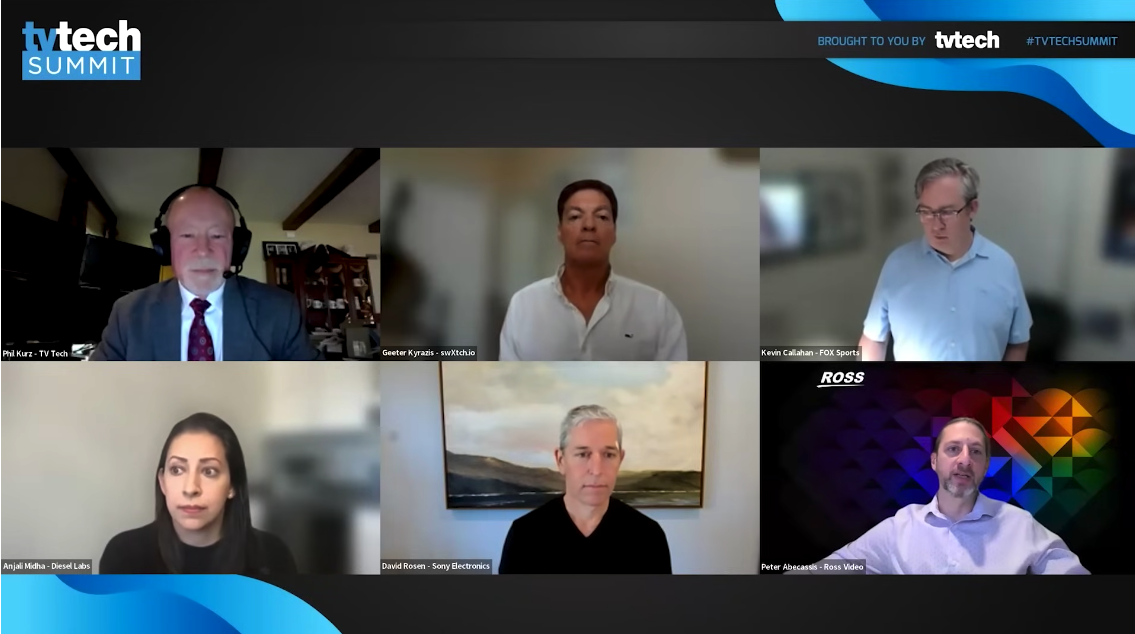TV Tech Summit Panel Examines Cloud, AI, IP Landscape
The panel looked at how these technologies are being and will be used to streamline production

The cloud, artificial intelligence and IP transport are leaving their mark on television production and operations and promise to only become even more integral to the workflows of broadcasters and other content producers, especially in making them more efficient.
That was the overall takeaway from the “Using the Cloud, AI and IP to Streamline Operations in 2024” panel during the TVTech Summit that went live today.
This and the rest of the summit panels as well as the event’s keynotes are available as VOD online.
The panelists, including Kevin Callahan, vice president of field operations and engineering at Fox Sports; Anjali Midha, co-founder and CEO of Diesel Labs; Geeter Kyrazis, chief strategy officer at swXtch.io; Peter Abecassis, director of product management for production workflow at Ross Video; and David Rosen, vice president of cloud applications at Sony Electronics; exchanged their views of how these technologies are being and will be used to improve workflows and content. swXtch.io, Ross Video and Sony Electronics were sponsors of the summit.
SMPTE ST2110 is playing an increasingly important role in production, and broadcasters and other content producers are turning to hybrid environments of on-prem, data center and public cloud resources to make that happen, said Kyrazis.
“Using 2110 and methods like multicast and PTP and compressed video and having one global production scheme across those networks is clearly something people want to do,” he said.
At present, the demands of moving uncompressed 2110 content from the ground to the cloud as well as some “logistical infrastructure factors” are making that difficult. “But in general, if you can solve the problems, the protocol and the features that are present in 2110 networks can work in the cloud,” he said, pointing to “lightly compressed formats,” such as TR-07, TR-08 and JPEG-XS, as examples of ways around bandwidth limitations.
The professional video industry's #1 source for news, trends and product and tech information. Sign up below.
Fox Sports is a case in point when it comes to leveraging the cloud as part of a hybrid deployment to streamline workflows and make content better, said Callahan.
For example, the broadcaster will conduct a proof-of-concept deployment that pairs its SMPTE ST2110-based flypacks with the cloud to power live frame rate conversion tasks. “Instead of having the bare metal expensive hardware that is purpose-built and serves one function we are looking to see where we can leverage it [the cloud] to perform multiple functions for us and spin up that temporary bandwidth—or overflow—that we need,” said Callahan, referencing framerate conversion.
A number of content producers are incorporating the cloud directly into their productions, said Rosen. “I think one of the major ways broadcasters and content producers can improve efficiency is by having content in a central location as quickly as possible, because then it doesn’t matter where the talent is or your other resources are. They can be easily interacted with.”
Rosen pointed to the National Hot Rod Association as an example of a content producer that has transitioned to the cloud to store contribution sources from its events and to make that content instantly available to editors to begin cutting their shows. “They are no longer waiting till the end of the day [to begin],” he said.
Another example is Fox Sports. Its content management system lives in the cloud, some of which is on-prem and other in a private cloud. “All of the content we have is in a central location and anyone can go ahead and access,” said Callahan, adding that Fox Sports is leveraging AI/ML tools to make it easier and faster to find content thereby improving the quality of its productions.
These applications are examples of the progress that’s been made in the past few years with cloud tools, said Abecassis. “The first cloud tools…felt like webpages—like toys to a certain extent,” he said. “They didn’t resemble what your typical technical director was used to in a control room. What we are seeing more and more of now are real ‘broadcast tools’ that are being ported to the cloud and being made cloud-focused to run anywhere.”
Another is generative AI, which for example, can be used in a newsroom setting to rewrite stories for different audience segments, to summarize content and to create social media and web versions of stories, said Abecassis. However, he cautioned generative AI is not currently capable of producing results that need not be read by someone in the newsroom to ensure the technology isn’t “filling them with nonsense.”
While AI tools are delivering a variety of production benefits, they are also being used to sift quickly through massive amounts of social media data to unearth nuggets about what’s trending and what people think about content—all of which can help content producers, including broadcasters, create better shows, said Midha.
“It is kind of the wild west right now, but in a really exciting way,” she said. “We [Diesel Labs] collect audience signals from across the entire spectrum of social and video platforms—all of the places audiences love to go and chatter about their favorite content,” she said.
Using AI solutions her company has built, Diesel Labs can feed its clients information about what people are saying about content in near-real time, which can be used to direct editorial decisions, she explained.
Phil Kurz is a contributing editor to TV Tech. He has written about TV and video technology for more than 30 years and served as editor of three leading industry magazines. He earned a Bachelor of Journalism and a Master’s Degree in Journalism from the University of Missouri-Columbia School of Journalism.

